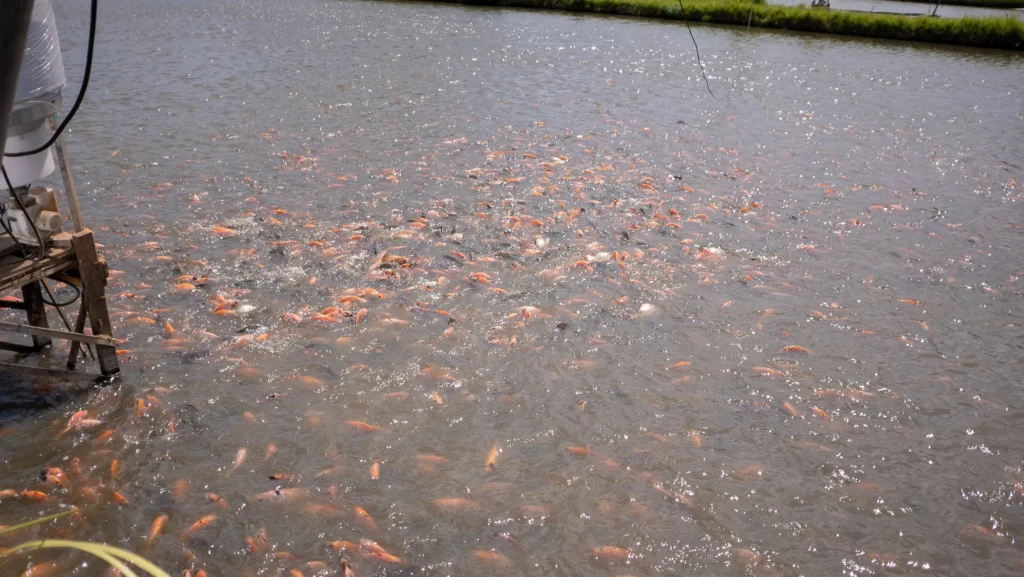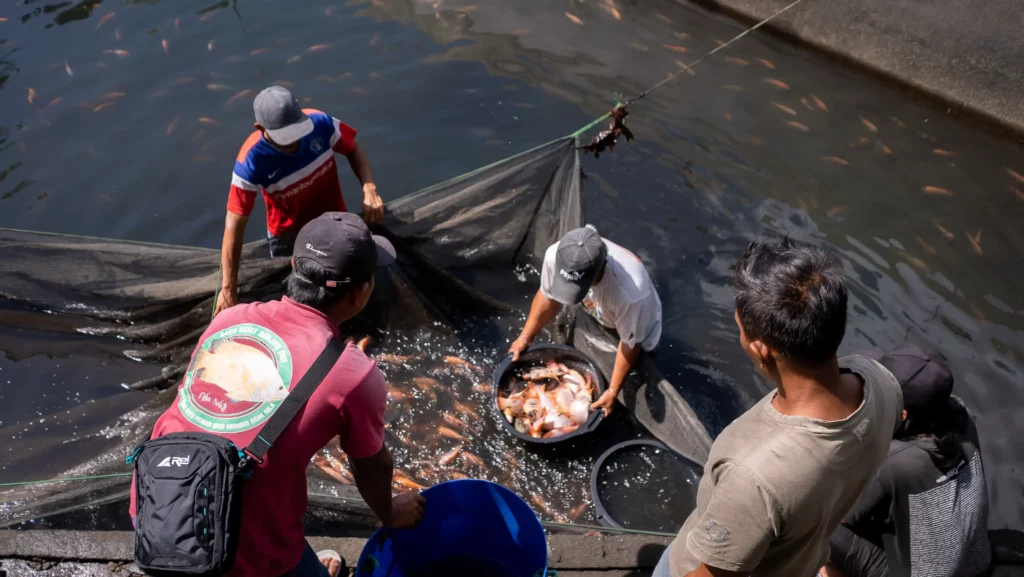Freshwater fish farming is a lucrative business. For those of you who like to raise fish, diving into freshwater fish farming is the right choice!
You can continue your hobby while earning a sizable income. If you are new to cultivating, you can start from a small pond so the risk level is also low.
There are many types of freshwater fish that have been cultivated in Indonesia. Here, there are 5 superior types of freshwater fish that have the potential to generate big profits. Not only that, we also provide accurate information on the stages in freshwater fish farming, to capital solutions for you in the freshwater fish farming business.
5 Types of Popular Freshwater Fish

Freshwater fish have many kinds! If you want to start cultivating freshwater fish, you need to know the types of freshwater fish that are popular for cultivation. Let's see together!
1. Goldfish
If we talk about freshwater fish, goldfish is the first thing that comes to our mind.
Carp cultivation generates large profits for the cultivators, because the price of carp is relatively high, ranging from Rp. 27,000 – Rp. 38,000/kg. Demand is also relatively stable and does not know the season.
Not only is it expensive, but it's also relatively easy to sell because of its wide market share. In fact, currently the demand exceeds production figures so it has a high sales opportunity.
You can harvest goldfish within 6-8 months with a weight of 300-400 grams per head. With a density of 40 fish per square meter, you can produce 12-16 kg of goldfish per square meter.
2. Tilapia
Tilapia is gaining popularity in the eyes of the fishing industry because it is easy to cultivate, easy to sell and stable in price. So, for those of you who are interested in freshwater fish farming, this fish can be the right choice.
Tilapia has a very high adaptability, from the ability to survive in ponds with high stocking densities, being able to adapt to low oxygen conditions to feeds with low nitrogen content. Thus, tilapia is classified as a freshwater fish that is easy to cultivate.
This freshwater fish also has enormous business potential. The price of tilapia is relatively expensive, ranging from Rp. 30,000 – Rp. 35,000/kg. In addition, the price is also relatively stable in the market so you don't have to worry about the price falling. Tilapia is also easy to sell because it is widely used as the main menu in various types of restaurants and eating houses.
In an area of one square meter, you can cultivate as many as 30 tilapia fish. With a single tilapia harvest weighing up to 500 grams, one harvest can produce 15 kg of tilapia per square meter. The harvest period is also relatively short, which is 4 to 6 months.
3. Gurame Fish
This type of freshwater fish is also easy to cultivate and can live in low oxygen conditions. Gurame fish can reproduce naturally and can live in stagnant water. In addition, the price is relatively expensive and classified as luxury dining.
Gurame fish has a price range of Rp. 45,000 to Rp. 60,000. Not only that, selling it is also not difficult because many people become fans of this type of fish. You can market carp directly to consumers through markets or sell it to restaurants that have carp menus.
With high productivity, namely 20 carp in one square meter, the carp weight ready for market reaches 500 grams, so every one square meter can produce 10 kg. This fish can also be harvested in a range of 10 to 12 months.
4. Catfish
This freshwater fish is called a special fish because it is a luxurious consumption fish but is also kept as an ornamental fish. The meat of catfish is low in sodium so it is suitable for people on a diet and contains calcium, iron and minerals.
Cultivating catfish is a big opportunity because the amount of demand currently exceeds production, so the market opportunity is wide open. Coupled with the price which is quite expensive, which ranges from Rp. 27,000 – Rp. 34,000/kg.
In a pond area of one square meter, you can stock 20-30 catfish. Its growth is relatively fast, within 6 months the catfish can reach a weight of 600 grams to 700 grams. Interesting right? You can start cultivating catfish to supplement your income.
5. Catfish
Who doesn't know this popular freshwater fish? That's right, catfish has gained popularity since the mushrooming of catfish pecel restaurants, so the demand continues to increase. Therefore, this type of freshwater fish is very potential for you to cultivate.
Cultivating catfish is also relatively easy and does not require special equipment. The stocking density of catfish is also very high, reaching 75-100 fish per square meter. In addition, the harvest period of this type of freshwater fish is also relatively faster than other types. You only need 2.5 months for the catfish to be marketed.
You already know the 5 types of freshwater fish that are popular among the public. You must have considered what type of fish to cultivate. But before that, let's take a look at how to cultivate freshwater fish effectively!
5 Ways to Cultivate Freshwater Fish

There are various types of freshwater fish farming methods that you can choose from. Here eFishery will summarize the most effective ways of cultivating freshwater fish. Let's see!
1. Preparing Freshwater Fish Cultivation Land
Before starting the cultivation process, you must have the right cultivation pond. Each type of freshwater fish has its own needs, so make sure the pond you make is suitable for the type of fish. There are several things that must be considered, such as the depth of the pool, sun exposure, and the aeration system.
Pond preparation is very important, especially to accelerate the growth of fish to be cultivated. There are many types of pools to choose from, ranging from concrete pools, tarpaulin pools, floating net pools, and earthen pools. Each type of pool has its advantages and disadvantages.
2. Selection of Freshwater Fish Seeds
Do you want to speed up the harvest of fresh water fish? If true, then selecting superior fresh water fish seeds is the answer. DBy selecting the right seeds, harvest time can be accelerated by up to 30% from the initial estimate.
The seeds that you choose must meet several criteria, such as being certified, disease free, and active. In addition, freshwater fish seeds must be fast in growth and easy to reproduce. You can look for these superior seeds at several fish shops and cultivators who develop superior varieties.
3. Spreading Freshwater Fish Seeds
After you have obtained superior freshwater fish seeds, the next step is to spread the seeds. Each type of freshwater fish has its own optimal seed stocking density, so stocking must be done at the right density. If the density is less, the efficiency of the pond will decrease. However, if the stocking density is too high, it will cause a decrease in fish productivity.
Before you sow freshwater fish seeds into the pond, you need to acclimatize the seeds.
First, Float the plastic filled with fish for 15-20 minutes. Second, open the plastic and mix the pool water into the plastic. Final, let the fish come out by itself. This is done so that the fish can adapt according to the pond environment. In addition, it can also prevent stress when fish are moved in the pond.
4. Feeding and Caring for Freshwater Fish
The amount of feed given must be adjusted to the needs of freshwater fish. If there is too much feed, the feed can settle, reducing the quality of pond water and triggering disease. The key is feeding with a weight of 3-4% of fish weight per day. Feeding only needs to be done two to three times a day, namely in the morning and evening.
Furthermore, you need to monitor environmental conditions for freshwater fish farming, such as temperature factors and water conditions. The suitability of pond water temperature depends on the type of fish being cultivated. In addition, the cleanliness of the water where the cultivation must also be maintained to prevent the presence of pests or diseases.
5. Freshwater Fish Harvesting
In order to get big profits, you need to adjust the weight of the fish according to market demand. In addition, you should make sure there are buyers who can absorb the harvest from freshwater fish before harvesting.
Cultivation of fresh water fish is interesting isn't it? If you are interested in fish farming, eFishery offer Kabayan (Love, Pay Later)!
Mulai Bisnis Budidaya Ikan Air Tawar dengan Kabayan
Starting from high productivity, to a large market share, freshwater fish farming has great business prospects. So what are you waiting for? Let's start freshwater fish farming!
Kabar baiknya adalah kini budidaya ikan air tawar bisa lebih mudah dengan aplikasi eFisheryKu. eFisheryKu adalah aplikasi yang dibuat untuk membantu Bapak/Ibu memajukan bisnis budidaya ikan. Aplikasi ini dilengkapi dengan berbagai fitur untuk mendukung proses budidaya, seperti akses ke lembaga keuangan yang terpercaya, terdaftar, dan diawasi oleh OJK, melalui Kabayan (Kasih, Bayar Nanti).
As is Kabayan, Bapak/Ibu bisa mendapat pakan, benih, dan sarana produksi lainnya yang bisa dibayar setelah panen. Keuntungan menggunakan Kabayan lainnya adalah proses cepat, bunga rendah, persyaratan mudah, akad perjanjian bisa secara syariah, pemesanan pakan atau saprokan melalui aplikasi, serta promo menarik lainnya. Pengajuan Kabayan it's also easy, you can register through the application eFisheryKu.
Tunggu apa lagi? Nikmati berbagai kebermanfaatan Kabayan dengan mengisi form di bawah ini!
Get Access to Financial Institutions that are Trusted, Registered & Supervised by OJK!
Fill in your personal data in the following form. Our team will immediately contact you via the number cellphone attached. Make sure the data entered is correct.
